
The
UNEXPLAINED
Mysteries of Mind Space and Time
 |
The
|
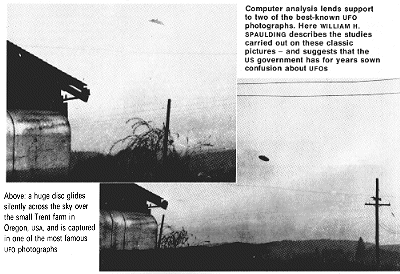
THE COMPUTER HAS BEEN USED to analyse two of the most impressive UFO photographs to date, taken by an American couple, Mr and Mrs Trent, near McMinnville, Oregon, USA. The computer study has endorsed and extended the findings of the expert appointed by the University of Colorado's Condon Committee - that the pictures show an object that is not explicable as any known phenomenon, natural or artificial.
By the Trents' own account, the object appeared over their small farm in the evening of 11 May 1950 (see page 28). It was seen by Mrs Trent as she fed the farm's rabbits, and she called her husband. The family camera was found, and Mrs Trent took two photographs from positions a few feet apart. There was no sound as the disc glided from the north-eastern part of the sky across to the north-west.
There were a few unused frames left on the roll of film. The Trents attached
so little importance to the pictures that they waited a few days, until they
had used up the rest of the film, before they had the roll developed. They
then ignored the photographs and it was only by chance that the local newspaper
heard about them. When they did, however, the pictures caused a sensation,
finally being featured in Life magazine. They were the only photographs that
were not dismissed by the US Air Force's highly sceptical Condon report of
1967, which was scathing about the mass of evidence presented to it. Their
investigator, William K. Hartmann, concluded that all the factors he had
investigated, both in the photographs and at the scene of the sighting, were
consistent with the assertion 'that an extraordinary flying object, silvery,
metallic, disc-shaped, tens of metres in diameter, and evidently artificial,
flew within sight of two
witnes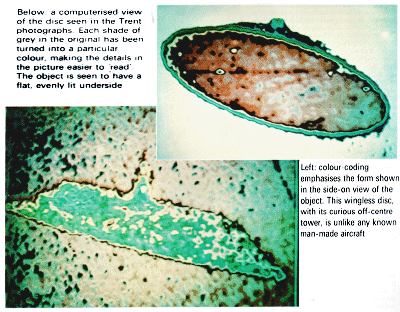 ses'.
The evidence, he said, did not positively rule out a hoax - which, coming
from a member of the Condon team, almost rates as an endorsement of authenticity.
ses'.
The evidence, he said, did not positively rule out a hoax - which, coming
from a member of the Condon team, almost rates as an endorsement of authenticity.
Controversy blew up around these photos, however, as it does around all UFO pictures that stand up to scrutiny (see box). The advent of the computer afforded an opportunity to review the Trent photographs in order to discover more than the human eye can see, even when it is aided by the microscope.
The principles involved in the computer study techniques used to analyse the photographs have already been described (see page 641). A television camera scans the picture, breaking it down into nearly a quarter of a millton pixels (picture cells) and recording the lightness or darkness of each pixel as a number stored in its memory. The computer can process these numbers in countless different ways to create new images, which it displays on a television screen. Each such picture has something new to say about the information contained in the original photographic negative.
Colour-contouring the image
The first thing that Ground Saucer Watch, the investigating organisation,
did with the Trent photos was to colour-contour the image, converting each
shade of grey in the original picture into a different bright colour The
result was to make the distribution of light and shade over the object far
easier to 'read'.
The lower surface of the disc shows only a few different shades, confirming an evenly lit, flat lower surface. The second photograph, showing the edge-on disc, disclosed a darker shade in the centre of the object than, at the extreme edges, which indicates a circular shape and bevelled disc profile.
The colour-coding technique makes the light-and-shade pattern of the image plainly visible to the eye. Detailed calculations by the computer provide a more sophisticated judgement confirming the detailed shape of the object shown.
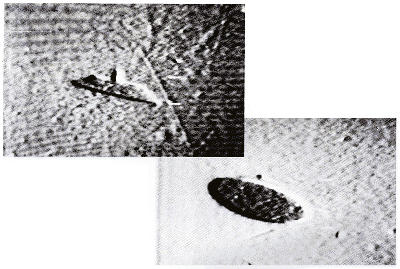
Hoax photographs generafly show such items as hub caps or dishes, but the obvious shapes of such objects would be resolved by the colour-contouring technique applied to the magnified image.
The computer technicians measured the lightness of the UFO image and compared it with the shadows that can be seen on the nearby garage. The UFO turned out to be much lighter. The most straightforward explanation of this effect is that the object is at a great distance from the camera. Atmospheric haze over that distance would veil the disc - just as an observer, looking at the distant horizon, finds that it looks paler than nearby foreground objects, even on days when the air is at its clearest. However, other possible factors, including reflected ground light and grease on the camera lens, have been brought into the controversy. But this objection cannot be brought against the estimation of the object's distance by means of the sharpness of the UFO image. The foreground objects, such as the telephone wires and the building, are sharper than the UFO and distant objects on the ground.
The next step in the analysis was to search for wires suspending or supporting
the disc, which would imply that the object was a small model, comparatively
close to the camera. To do this, the group took advantage of the
edge-enhancement facility of the computer.
The resulting pictures have something of the look of a bas-relief carved
in rough stone and lit at a low angle. Bright and dark lines now mark the
edges of features on the object, and even snicall flaws in the negatives.
The edge-enhancement technique can reveal, under typical conditions, the
presence of a wire less than one hundredth of an inch (it quarter of a
millimetre) thick, at a distance of 10 feet (3 metres). There is definitely
no evidence of such a supporting wire or string in the area around the object.
The edge-enhancement technique not only ruled out the theory of a suspended
model: it made it easy for Ground Saucer Watch to make measurements of the
size of the image, which, when coupled with the analysts' assessment of the
distance of the object, enabled them to draw conclusions about its true size.
Results of the analysis
The accumulated evidence gleaned from the several lines of attack that Ground
Saucer Watch followed in its computer study led the organisation to the sober
conclusion that the picture shows a flying disc, between 65 and 100 feet
(20 and 30 metres) in diameter, and probably made of polished metal (since
its light reflection was consistent with laboratory specimens of metal).
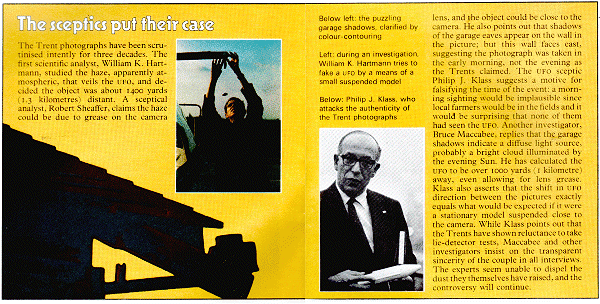 |
| The Trent photographs have been scrutinised intently for three
decades. The first scientific analyst, William K. Hartmann, studied the haze, apparently atmospheric, that veils the UFO, and decided the object was about 1400 yards (1.3 kilometres) distant. A sceptical analyst, Robert Sheaffer, claims the haze could be due to grease on the camera lens, and the object could be close to the camera. He also points out that shadows of the garage eaves appear on the wall in the picture; but this wall faces east, suggesting the photograph was taken in the early morning, not the evening as the Trents claimed. The UFO sceptic Philip J. Klass suggests a motive for falsifying the time of the event: a morning sighting would be implausible since local farmers would be in the fields and it would be surprising that none of them had seen the UFO. Another investigator, Bruce Maccabee, replies that the garage shadows indicate a diffuse light source, probably a bright cloud illuminated by the evening Sun. He has calculated the UFO to be over 1000 yards (1 kilometre) away, even allowing for lens grease. Klass also asserts that the shift in UFO direction between the pictures exactly equals what would be expected if it were a stationary model suspended close to the camera. While Klass points out that the Trents have shown reluctance to take lie-detector tests, Maccabee and other investigators insist on the transparent sincerity of the couple in all interviews. The experts seem unable to dispel the dust they themselves have raised, and the controversy will continue. |
The entire UFO phenomenon deserves a properly conducted scientific investigation, undistorted by preconceived opinions. Modern technology has the means to make progress on the subject. However, there is a factor that impedes serious UFO research. Most governments have preferred to conceal the full extent of their own evidence from their citizens. The United States government probably has available to it the largest pool of data that exists anywhere in the world - data that have come from its own employees, military personnel, policemen and ordinary citizens. Civilian UFO researchers have long asserted that the United States intelligence agencies are aware of the existence and origins of UFOS. For more than 25 years they have maintained that the government knew more than it was telling. On numerous occasions when the government became involved in the investigation of a sighting, evidence would mysteriously disappear or be destroyed. The computer and other modern aids to analysis cannot demonstrate their full potential while vital evidence is withheld.
However, the Freedom of Information Act now gives American citizens powers to compel their government to disclose the information that its agencies hold on file. The first legal skirmishes have taken place and documents that the CIA would have preferred to keep to itself have been made available to ufologists.
It may prove, as more information is prised from unwilling hands, that the role of the US government has been more active than previously suspected - that the clouding of UFO investigation they have brought about is due to more than the usual torpor, confusion and conservatism of government departments. On the contrary, some small and as yet unidentified group within the government machine may have been manipulating public opinion and the work of ufologists. They could have done this by familiar techniques of 'disinformation' - releasing distorted reports and data, starting rumours, feeding ufologists with 'confidential' but misleading stories - even setting up the occasional spurious sighting. Thev would have done this to set up a background of widespread UFO belief- at the same time that other government agencies were busily debunking UFOS.
There could be several motives for such a devious strategy. Public attention has occasionally been distracted from other issues by well-timed 'saucer flaps'. For example, a wave of sightings over Texas and New Mexico occurred within hours of the news of the Soviet Union's launching of a second Sputnik in November 1957, at a time when Amenca's Vanguard rockets were failing to get off the launch pad
The long-runmng UFO story could also provide vast quantities of data on the
psychology of individuals and groups as they found themselves under supposed
surveillance by unknown and possibly threatening forces. The official interest
in the psychological warfare aspects of UFO scares is documented in secret
memoranda only now becoming
available.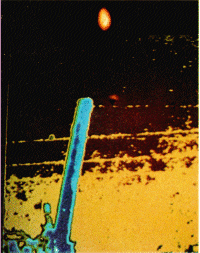
The plethora of sightings that has grown up during the last 30 years could also serve to bury the occasional sighting of advanced types of aircraft by citizens or unauthorised service personnel.
A UFO tradition
An agency wishing to foment a UFO tradition and the occasional outbreak of
UFO hysteria would not need to do a great deal. The enthusiasts and the general
public would do it for them, at the stimulus of a few hints, added to the
UFO reports made in good faith. 13etter analysis of UFO data of all kinds,
in which computerised image-processing has a large part to play, can improve
the situation by countering such a campaign and combatting the extremes of
credulity and scepticism. But for this all the evidence hidden in government
files is needed.
So, while Ground Saucer Watch adheres firmly to its judgement that remarkable physical phenomena lie behind many of the UFO photographs, it believes that the battle to discover the true nature and origin of those phenomena may be fought out in the courtroom before it can be taken up in the photo analyst's laboratory.
What questions should you ask when you see a UFO photograph? See page 690
Sue Blackmore UFO Aliens and Departed Spirits Little Green men or Not? Are there aliens on our moon?
Reproduced from THE UNEXPLAINED
p674